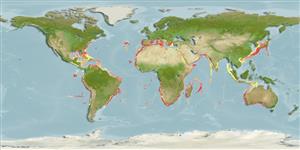Common names from other countries
>
Acropomatiformes (Oceanic basses) >
Epigonidae (Deepwater cardinalfishes)
Etymology: Epigonus: Greek, epi = over, in front + Greek, gonio = angle (Ref. 45335).
Environment: milieu / climate zone / depth range / distribution range
Ecología
marino batidemersal; rango de profundidad 130 - 830 m (Ref. 31632), usually 300 - 600 m (Ref. 4738). Deep-water; 43°N - 44°S, 98°W - 142°E
Cosmopolitan. Western Atlantic: Gulf of Mexico and Caribbean Sea. Eastern Atlantic: along the west coast of Africa to the southern tip of the continent, also western Mediterranean to southern Adriatic Sea. Indian Ocean: Reunion (Ref. 33390). Western Pacific: southwest coast of Japan, southern Australia and eastern New Zealand. Central Pacific: Hawaiian Ridge (Ref. 31632).
Tamaño / Peso / Age
Maturity: Lm ? range ? - ? cm
Max length : 20.0 cm TL macho / no sexado; (Ref. 4329)
Espinas dorsales (total) : 7; Radios blandos dorsales (total) : 10; Espinas anales: 2; Radios blandos anales: 8 - 9. Lacks opercular spines (Ref. 31632). Membranous edge at upper border of the gill cover is well developed. Caudal peduncle elongated, body not deep (Ref. 31632). Pyloric caeca 10-14. Preserved specimens are brownish to yellowish in color, dorsally darker. Numerous brown-black melanophores on scale pockets.
Adults benthic on the continental slope and collected with bottom trawls (Ref. 7321). Juveniles are pelagic in depths of 130-145 and 350-425 m (Ref. 9563). Feed on small fishes and planktonic invertebrates (Ref. 4738). Oviparous (Ref. 4738).
Life cycle and mating behavior
Maturities | Reproducción | Spawnings | Egg(s) | Fecundities | Larva
Maugé, L.A. and G.F. Mayer, 1990. Apogonidae. p. 714-718. In J.C. Quero, J.C. Hureau, C. Karrer, A. Post and L. Saldanha (eds.) Check-list of the fishes of the eastern tropical Atlantic (CLOFETA). JNICT, Lisbon; SEI, Paris; and UNESCO, Paris. Vol. 2. (Ref. 7321)
IUCN Red List Status (Ref. 130435)
CITES (Ref. 128078)
Not Evaluated
Threat to humans
Harmless
Human uses
Herramientas
Warning: mysqli::__construct(): (HY000/1040): Too many connections in /var/www/html/includes/speciessummary.lib.php on line 2104
Can't connect to MySQL database fbquizv2. Errorcode: Too many connections
